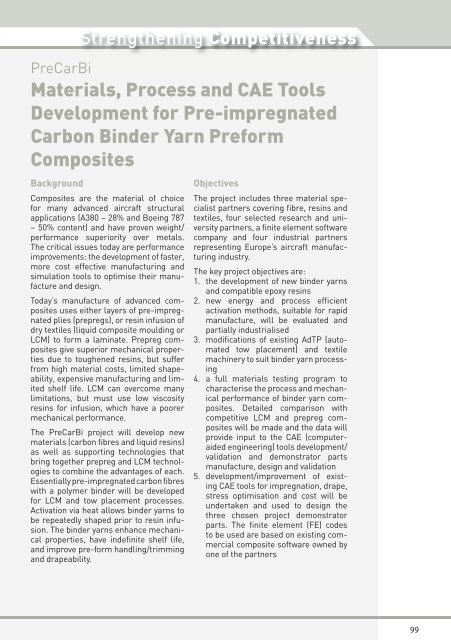Aeronautics Research 2002 - 2006 projects
Aeronautics Research 2002 - 2006 projects
Aeronautics Research 2002 - 2006 projects
You also want an ePaper? Increase the reach of your titles
YUMPU automatically turns print PDFs into web optimized ePapers that Google loves.
Background<br />
Strengthening Competitiveness<br />
PreCarBi<br />
Materials, Process and CAE Tools<br />
Development for Pre-impregnated<br />
Carbon Binder Yarn Preform<br />
Composites<br />
Composites are the material of choice<br />
for many advanced aircraft structural<br />
applications (A380 – 28% and Boeing 787<br />
– 50% content) and have proven weight/<br />
performance superiority over metals.<br />
The critical issues today are performance<br />
improvements: the development of faster,<br />
more cost effective manufacturing and<br />
simulation tools to optimise their manufacture<br />
and design.<br />
Today’s manufacture of advanced composites<br />
uses either layers of pre-impregnated<br />
plies (prepregs), or resin infusion of<br />
dry textiles (liquid composite moulding or<br />
LCM) to form a laminate. Prepreg composites<br />
give superior mechanical properties<br />
due to toughened resins, but suffer<br />
from high material costs, limited shapeability,<br />
expensive manufacturing and limited<br />
shelf life. LCM can overcome many<br />
limitations, but must use low viscosity<br />
resins for infusion, which have a poorer<br />
mechanical performance.<br />
The PreCarBi project will develop new<br />
materials (carbon fi bres and liquid resins)<br />
as well as supporting technologies that<br />
bring together prepreg and LCM technologies<br />
to combine the advantages of each.<br />
Essentially pre-impregnated carbon fi bres<br />
with a polymer binder will be developed<br />
for LCM and tow placement processes.<br />
Activation via heat allows binder yarns to<br />
be repeatedly shaped prior to resin infusion.<br />
The binder yarns enhance mechanical<br />
properties, have indefi nite shelf life,<br />
and improve pre-form handling/trimming<br />
and drapeability.<br />
Objectives<br />
The project includes three material specialist<br />
partners covering fi bre, resins and<br />
textiles, four selected research and university<br />
partners, a fi nite element software<br />
company and four industrial partners<br />
representing Europe’s aircraft manufacturing<br />
industry.<br />
The key project objectives are:<br />
1. the development of new binder yarns<br />
and compatible epoxy resins<br />
2. new energy and process effi cient<br />
activation methods, suitable for rapid<br />
manufacture, will be evaluated and<br />
partially industrialised<br />
3. modifi cations of existing AdTP (automated<br />
tow placement) and textile<br />
machinery to suit binder yarn processing<br />
4. a full materials testing program to<br />
characterise the process and mechanical<br />
performance of binder yarn composites.<br />
Detailed comparison with<br />
competitive LCM and prepreg composites<br />
will be made and the data will<br />
provide input to the CAE (computeraided<br />
engineering) tools development/<br />
validation and demonstrator parts<br />
manufacture, design and validation<br />
5. development/improvement of existing<br />
CAE tools for impregnation, drape,<br />
stress optimisation and cost will be<br />
undertaken and used to design the<br />
three chosen project demonstrator<br />
parts. The fi nite element (FE) codes<br />
to be used are based on existing commercial<br />
composite software owned by<br />
one of the partners<br />
99

















